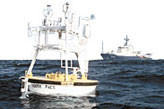Format Options
EPIC
EPIC is an implementation of the binary file storage and retieval
system called NetCDF. For more information on NetCDF, see the Unidata web
site at
http://www.unidata.ucar.edu/packages/netcdf/.
Documentation on the EPIC implementation is available at
http://www.epic.noaa.gov/epic/document/index.html.
Although NetCDF/EPIC files are binary, they are portable across platforms with different internal data notation systems. File access is done with libraries that are included in the NetCDF distribution. Interfaces are available for Matlab and other processing systems.
ASCII
- cmomet.asc.z
- cmomet.meta
ASCII files are provided as flat files, blank separated. The first column is always yearday, and the order of subsequenst variables is described in the metadata file.
For 2-dimensional oceanographic data sets, all variables for a given depth/time appear together, and bins are presented in descending order.
Our yearday convention is that Noon UTC on January 1 is day 1.5. Multiple year experiments are normally presented relative to January 1 on the year of deployment.
Wind and currents are reported in oceanographic convention, or direction towards which the flow is going. NOTE: This is the opposite of meteorological convention.
Metadata is provided separately, to make the data files easier to use.
Please be sure to download the appropriate .meta file. For
example:
File Compression
Files are compressed with gzip and can be uncompressed on
Mac, PC, or UNIX systems. If you have trouble uncompressing with
your old software, try downloading a new copy of gzip.
Last updated: March 21, 2008

